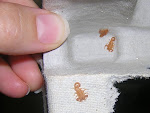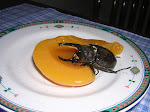Just to create a little contrast to today's events, two weeks ago the Ethan fire was ignited by lightening from a dry thunderstorm. The monsoon season commonly delivers cloud-to-ground lightening strikes and high winds. But when the only moisture is a hint of virga, the Sonoran desert brush can flare up like a gasoline saturated torch.
Today...the monsoon season delivered a much wetter one that boasts a new record rainfall for this date: 1" in one hour. The storm wasn't even on forecaster's radar this morning, but by 4 PM the Phoenix valley was rumbling and drenched without warning. Flooded (and closed) freeways, lake-like parking lots and stranded shoppers, and saturated homes sprung up before news casters could give proper warning.
The two storm cells first converged over my neighborhood (interesting, what is it with my area?) and dumped for an extended period whilst battling over which direction to go next. A number of cars in my complex -- including Jack's, parked next to mine -- were overcome with flood waters. (Thank goodness Blanca is a RAV4 and has high clearance.) Several apartments at the base of this hill behind us were flooded with a foot of water. Rain in the desert comes down fast and moves fast once on the ground. It is also fast to recede; the pic below is nothing compared to a moment before.
Whatever you're doing, monsoon season thunderstorms are worth stopping to observe. People get downright giddy. At the very least, storms deliver a momentary drop in temperature and the opportunity to step outside without ducking for shade. For others, the storms are entertaining and break up the monotony of predictable weather. For me, it's all that plus the bugs. Monsoon critters are just the coolest. Moments after the 40-minute downpour let up, an Anna's hummingbird ventured out to to dine on flying termites ("alates"). These reproductive forms emerge en masse following summer thunderstorms. I've seen these insects thick as snow, from ground level to more than a hundred feet up...Crazy! The little Anna's belly bulged as he (she? fledgling?) gorged on fluttering termites, then washed them down with a swig from my feeder.
Termites aren't the only thing emerging en masse. Spadefoot toad's are abundant, too. Every summer they emerge from their long respite underground, called to the surface by the vibration of heavy rain and thunder. Temporary ponds, like the spill pond behind my building, are their preferred location. The idea is to emerge and breed for the monsoon season, then be gone again. Their call is likened to a bleating lamb; however, my neighbors asked if it wasn't a cat in distress (a comparison I'd have to agree with). Louder than anything I've heard in the desert, Spadefoot toads begin calling in the early evening and go all...night...long. The stereo, dryer and a/c combined can't drown them out from behind closed doors. I wonder...do they make "scaretoads"?
The 2008 monsoon season has already delivered more than twice the amount of rainfall to parts of Phoenix than the entire 2007 season. And it's only half over! A beheaded lizard and a 3" beetle were at my stairs the other night... I can't wait to see what the season brings next.
Sunday, July 13, 2008
Monday, July 7, 2008
Monday Myth: Cockroaches...They Ain't No Fly
Cockroaches get a bum wrap. They "creep" and "crawl", but then so does every other arthropod. They come into our homes, offices and schools... But so do fleas, spiders and the like. And for reasons I don't fully understand, cockroaches take the cake on the "ew" factor of filth. But in fact, cockroaches are NOT the dirtiest insect around, and indoor infestations are often indicative of "dirty" conditions on our part (throwing the "ew" factor right back at us).
The truth: cockroaches are not the slum-lords of the insect world. They aren't to blame for the filth; they just stop by to help clean it up, adding their two bits here and there. To find true ew, you have to look elsewhere. There is probably one in your home right now. They have been proven to carry more species of bacteria than a cockroach. It belongs to one of the largest orders of insects (Diptera, personally my least favorite): the House fly, Musca domestica.
 Why? How comes here this evil? House flies breed in decaying organic matter -- especially feces. As adults, they feed readily on sewage, garbage, and your lunch -- landing on all three indiscriminately. In addition, House flies have sponging mouth parts which means they can only lap up liquid. So after landing on a food source, they regurgitate to soften it, and then use their spongy labella to feed like a dog drinking water. They also defecate on their food at the same time. Lovely. With all this landing and regurgitating and crapping, the perfect storm of pathogen transfer is created. In addition to a variety of the nastiest bacteria affecting humans, the House fly may also transmit typhoid, cholera, polio and other intestinal diseases, as well as protozoan parasites such as Toxoplasma and Giardia. In essence: the House fly puts cockroaches to shame.
Why? How comes here this evil? House flies breed in decaying organic matter -- especially feces. As adults, they feed readily on sewage, garbage, and your lunch -- landing on all three indiscriminately. In addition, House flies have sponging mouth parts which means they can only lap up liquid. So after landing on a food source, they regurgitate to soften it, and then use their spongy labella to feed like a dog drinking water. They also defecate on their food at the same time. Lovely. With all this landing and regurgitating and crapping, the perfect storm of pathogen transfer is created. In addition to a variety of the nastiest bacteria affecting humans, the House fly may also transmit typhoid, cholera, polio and other intestinal diseases, as well as protozoan parasites such as Toxoplasma and Giardia. In essence: the House fly puts cockroaches to shame.
Yet we shoo them away like a minor nuisance. Or go overboard and 'zap' them, spewing their guts and bacteria far and wide with greater efficiency than even they could have realized. But there is a middle ground... Fly swatters work great, as do tight-fitting window screens and closed screen doors. There are light traps (that don't zap) with sticky boards and pheromone traps of all sorts one can hang up, too. Managing breeding and feeding sources (garbage, feces, moist piles of lawn clippings) greatly helps reduce House fly numbers considering that a single female produces 75-150 eggs PER BATCH (with 5-6 batches in her life of less than a month). s Biological controls in the form of parasitic wasps, which kill fly larvae, can be released in large numbers on farms (dairies and feedlots are are often acquainted with this option).
Pesticides are not an inherent part of successful fly management. Fly strips, automatic spray dispensers, and other pesticide employments are reactive and do not address the source of the problem. Discovering and eliminating the feeding and breeding sources of House flies is cheaper in the long run, and a better investment of time.
Cockroaches are also known to carry a variety of bacteria. And they sport proteins in their exoskeletons which irritate asthmatics. But at least they're not...House flies. There's more good stuff on fly management at UC Davis.
The truth: cockroaches are not the slum-lords of the insect world. They aren't to blame for the filth; they just stop by to help clean it up, adding their two bits here and there. To find true ew, you have to look elsewhere. There is probably one in your home right now. They have been proven to carry more species of bacteria than a cockroach. It belongs to one of the largest orders of insects (Diptera, personally my least favorite): the House fly, Musca domestica.
 Why? How comes here this evil? House flies breed in decaying organic matter -- especially feces. As adults, they feed readily on sewage, garbage, and your lunch -- landing on all three indiscriminately. In addition, House flies have sponging mouth parts which means they can only lap up liquid. So after landing on a food source, they regurgitate to soften it, and then use their spongy labella to feed like a dog drinking water. They also defecate on their food at the same time. Lovely. With all this landing and regurgitating and crapping, the perfect storm of pathogen transfer is created. In addition to a variety of the nastiest bacteria affecting humans, the House fly may also transmit typhoid, cholera, polio and other intestinal diseases, as well as protozoan parasites such as Toxoplasma and Giardia. In essence: the House fly puts cockroaches to shame.
Why? How comes here this evil? House flies breed in decaying organic matter -- especially feces. As adults, they feed readily on sewage, garbage, and your lunch -- landing on all three indiscriminately. In addition, House flies have sponging mouth parts which means they can only lap up liquid. So after landing on a food source, they regurgitate to soften it, and then use their spongy labella to feed like a dog drinking water. They also defecate on their food at the same time. Lovely. With all this landing and regurgitating and crapping, the perfect storm of pathogen transfer is created. In addition to a variety of the nastiest bacteria affecting humans, the House fly may also transmit typhoid, cholera, polio and other intestinal diseases, as well as protozoan parasites such as Toxoplasma and Giardia. In essence: the House fly puts cockroaches to shame.Yet we shoo them away like a minor nuisance. Or go overboard and 'zap' them, spewing their guts and bacteria far and wide with greater efficiency than even they could have realized. But there is a middle ground... Fly swatters work great, as do tight-fitting window screens and closed screen doors. There are light traps (that don't zap) with sticky boards and pheromone traps of all sorts one can hang up, too. Managing breeding and feeding sources (garbage, feces, moist piles of lawn clippings) greatly helps reduce House fly numbers considering that a single female produces 75-150 eggs PER BATCH (with 5-6 batches in her life of less than a month). s Biological controls in the form of parasitic wasps, which kill fly larvae, can be released in large numbers on farms (dairies and feedlots are are often acquainted with this option).
Pesticides are not an inherent part of successful fly management. Fly strips, automatic spray dispensers, and other pesticide employments are reactive and do not address the source of the problem. Discovering and eliminating the feeding and breeding sources of House flies is cheaper in the long run, and a better investment of time.
Cockroaches are also known to carry a variety of bacteria. And they sport proteins in their exoskeletons which irritate asthmatics. But at least they're not...House flies. There's more good stuff on fly management at UC Davis.
Subscribe to:
Comments (Atom)



+reduced.jpg)

